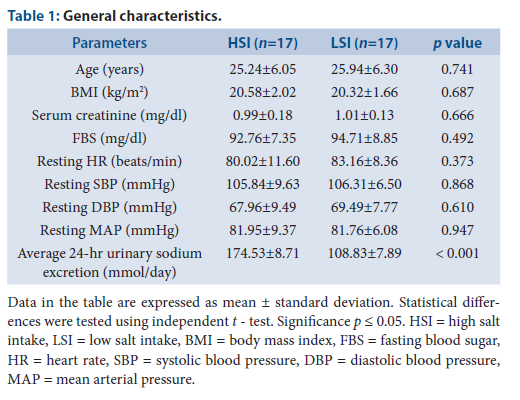Cardiovascular Autonomic Function in Normotensive Men with High Salt and Low Salt Intakes
Abstract
Background and Aim: The autonomic nervous system may play an important role in saltinduced increases in blood pressure (BP). The aim of this study is to assess and compare the heart rate (HR) responses to Valsalva maneuver, deep breathing and standing and BP responses to standing and sustained handgrip between normotensive men with habitual high salt intake (HSI) and low salt intake (LSI). Methods: Twenty-fourty years old normotensive men (n=34; n=17 for HSI and n=17 for LSI) were recruited by collecting 4 early morning spot urine samples. Average estimated 24-hr sodium (Na+) excretion of 4 urine samples of ≥166 mmol/day was regarded as HSI and <115 mmol/day as LSI. Heart rate responses to Valsalva maneuver, deep breathing and standing (parasympathetic function tests) and BP responses to standing and sustained handgrip (sympathetic function tests) were investigated in both groups. Results: Valsalva ratio (VR) [1.64±0.36 (HSI) vs 1.78±0.49 (LSI)], deep breathing difference (DBD) [24.51±9.56 beats/min (HSI) vs 22.93±6.37 beats/min (LSI)] and 30:15 ratio [1.34 (1.12–1.46) (HSI) vs 1.19 (1.13–1.52) (LSI)] were not significantly different in both groups. Systolic blood pressure (SBP) change from lying to standing [-0.67 (-4.00–9.00) mmHg (HSI) vs 0.00 (-3.34–2.34) mmHg (LSI)] was not significantly different between the two groups whereas diastolic blood pressure (DBP) rise in sustained handgrip [18.20±3.49 mmHg (HSI) vs 14.77±4.71 mmHg (LSI)] was significantly higher in the HSI (p=0.022). Conclusion: Cardiovascular sympathetic activity appears to increase in normotensive men with habitual high salt intake.






